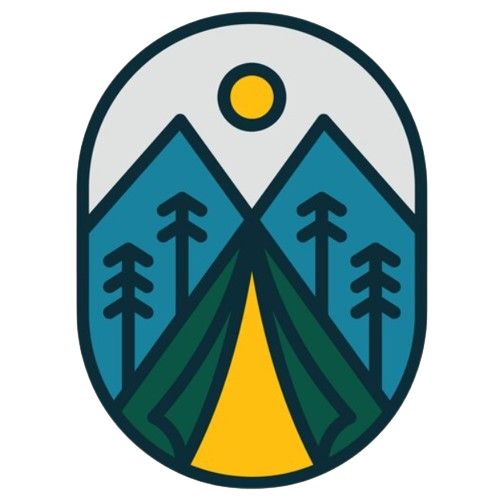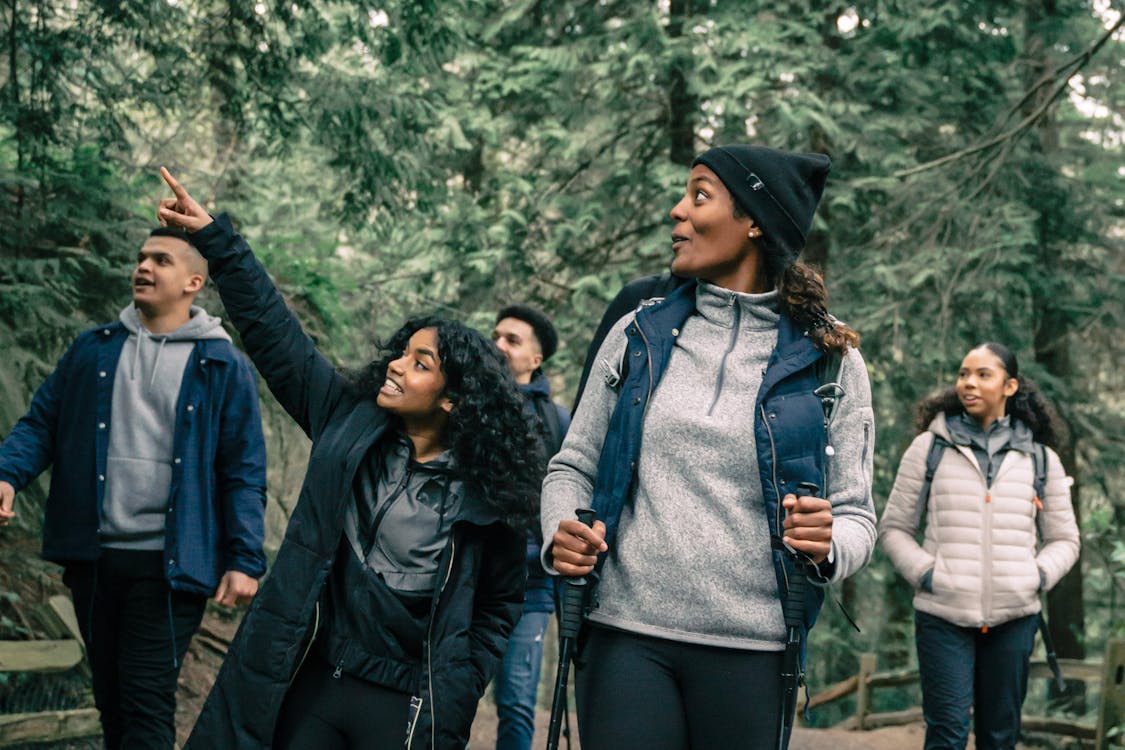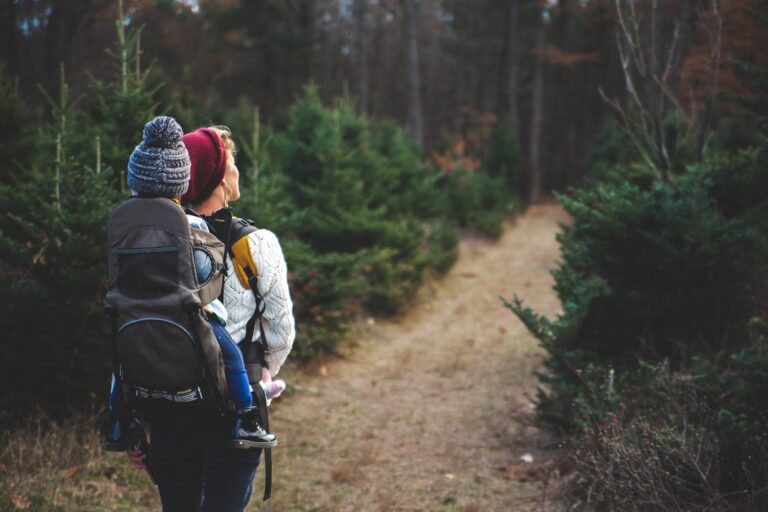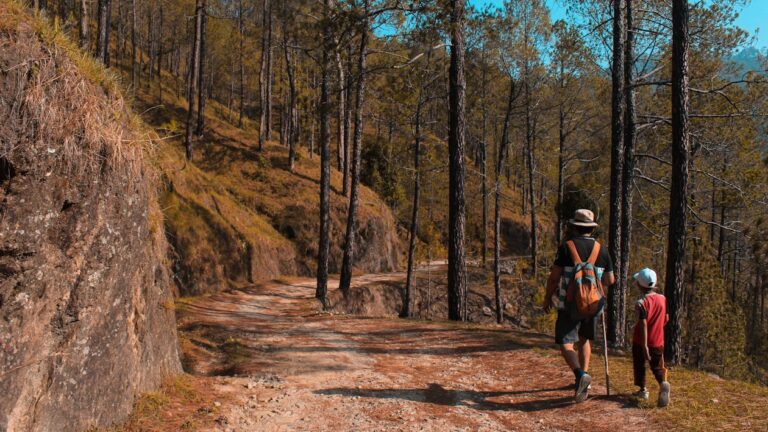The Whole Guide for Hiking Rookies
Do you want to go outside and put on your boots but are unsure of where to begin? All the information you need is in this tutorial on hiking for beginners!
You have a long journey ahead of you, your hiking boots on, and your worries at home.
You are encircled by dense nature as you leave behind the built world. The only sound in the area was the peaceful symphony of birdsong, streams flowing, and a breeze moving through the trees. There were no cars or people talking.
Feel the sun on your skin, breathe in fresh air, and smell the environment around you. A world of adventure awaits you ahead.
Welcome to the world of hiking!
It’s 100% everything it’s cracked up to be, and so much more. If you want to hit the trail but you’re not sure where to start, you’ve come to the right place!
Over the years we’ve learnt all the hiking tips and tricks and have put them together in this guide. You’ll find all the info you need to become a hiking pro, no matter your level of fitness or experience. Everything you need right here.
In this hiking guide you’ll find:
- What is hiking?
- The benefits of hiking
- How to plan and prepare for a hike (incl. different types of hiking, picking the right hike for YOU and how to find the best trails)
- What to pack for hiking trips
- What clothes to wear hiking
WHAT IS HIKING?
According to the Cambridge Dictionary, it’s “the activity of going for long walks in the countryside” but we think it’s more than that.
Hiking is when you deliberately spend time walking in a natural setting, often done on hiking trails. These trails can go through mountains, lakesides, forests, deserts etc, can take hours to months to complete and would be at the least light exercise.
At the same time, it also doesn’t have to be done at a high intensity, or a long period of time, and it doesn’t need to be about getting from A to B. Our advice is to plan your first hiking trail and find out exactly what it means to you.
WHY IS HIKING SO GREAT?
There are hundreds of hiking benefits but these are just some of the most important ones…
- It’s the perfect exercise – from easy walking trails around a lake to intense multi-day hikes across mountain ranges. It’s a great cardio workout that uses all of the muscles in your body without being overly strenuous and with little risk of injury.
- It helps you appreciate the outdoors – Ethical adventures are the answer to a whole lot of problems and hiking particularly helps you value the natural world.
- Hiking is free to everyone and very accessible – You don’t need to find a team, buy a membership, go at a certain time or buy loads of fancy equipment. All you need is a natural setting and the desire of spending time outdoors. Anyone can hike and it’s completely free!
- A time to switch off – Put your phones away, forget about social media and leave the emails at home. Hiking is a time to unplug.
- Hiking is scientifically proven to be good for mental health – According to the University of British Columbia: “any form of immersion in the natural world, outside of your internal world, heightens your overall well-being and improves your positive engagement with the larger human community”. It’s also used as a tool to treat depression and other mental health illnesses – definitely a winner!
STEP 1: HOW TO PLAN AND PREPARE FOR A HIKE
To make the most of your time on the trail, a little planning goes a long way (particularly for first-time hikers). The good news is that hiking prep is surprisingly easy, and we’ve gone through the steps below.
Oh, and if you’re planning a BIG trip, you might also want to check out our guide on how to plan an adventure quickly and easily.
1.1 Different types of hiking to choose from
There are quite a few different types of hikes, some more suited to beginners than others.
- Day hike – started and finished in a day but the difficulty and technicality can change. These are normally the best hikes for beginners to build up experience.
- Walks – typically refer to a short or easy hike. A very good option for beginners wanting to start simple.
- Multi-day hike – multi-day hiking is done over a number days, normally camping overnight. There are more elements to think about and physically harder so less suitable for new hikers.
- Trekking – normally describes long, tough, multi-day hiking and better left for the more experienced.
- Thru-hike – an American term used for hiking very long routes like the Appalachian Trail or Pacific Crest Trail. Requires lots of planning and physical strength so better to build up to.
- Section hiking – another American term for hiking individual sections of longer thru-hiking trails. Good preparation to build up for thru-hikes.
- Backpacking – this means multi-day hiking trips with your gear and camping equipment carried in your backpack. Again, has many aspects to think and is better for more experienced hikers.
- Loop – a hike that starts and finishes in the same place going in a loop. Quite enjoyable as you’re constantly seeing new scenery.
- One way hike – hiking from point A to B. The hike may finish at the ending point or you could come back on yourself to return to the starting point.
- Summit hike – when the main objective is to reach the summit or a peak. This is not necessarily a bad choice for beginners as you can find many smaller peaks which are safe and easily achievable in a day.
- Ridge walk – hiking trails that go along the ridge or edge of mountain areas. Often there is more risk involved and should be attempted by confident hikers.
- Technical – for hikes which require technical ability and equipment, with more risk of danger – not advised for beginners.
- Scramble – hikes which involve aspects of climbing and using both your hands and feet. Typically not suited to beginners as they can be more technical and dangerous.
- Mountaineering – very technical climbing of mountains.
Short day hikes are great starting points to safely build up confidence and knowledge. Then, you can slowly build up to more demanding hikes when you’re ready.
And if you’re thinking of camping on your hiking trip, you might wanna check out our Beginner’s Camping Guide and Packing List too

1.2 Picking the right hike for you
If you’re just starting out we’d suggest thinking about your ideal hike. To find the perfect route, there are a few things you need to think about:
- Location
- Hiking distance
- Elevation Gain (how much altitude you will gain)
- Difficulty
- Time needed
Pick the right hike for YOU and the time you have.
For your first one, pick something close to home which is easily within your fitness level and not too technical.
Pay particular attention to elevation gain! Even if a hiking trail is short it could be made much harder if it’s all uphill or on difficult terrain.
1.3 Where to find hiking trails
Now you know the kind of hike you want to go on it’s time to start looking for the trail.
Keep in mind the details listed above and whether you’ll find amenities for food, water, shelter etc closeby.
Below are some good places to find hikes nearby or inspiration further afield:
- ‘Hikes near me’ platforms – Use interactive maps to find hikes close to you – All Trails, MapMyWalk, Outdoor Active (also shows other outdoor activities) and Hiking Project (good for America) are all great sources for outdoor inspiration.
- Local hiking information or national park websites – If you know a certain area, national park or even country you want to find hiking trails in then try a Google search for the area name + hiking e.g ‘Peak District National Park hiking’ or ‘Pyrenees hiking’. You could also search for ‘hiking near me’ or ‘beginner hiking trails near me’ if you’re looking for something easier.
- You’ll find trails from national websites (like National Trails in the UK), specific websites for certain regions (like this one for hikes in the Mont Blanc region) or even from national park websites like this from the Bavarian Forest National Park in Germany.
- Online communities – You’ll find a wealth of information on different social platforms and forums. Facebook has some excellent hiking groups – this one is really useful for the UK but you’ll find plenty more by searching for different locations + hiking in the Facebook groups section.
- Hiking and outdoors blogs (like this one!) – These can be great places to find different hiking routes and tips, some of our favourites are Bald Hiker (perfect for the UK) and Modern Hiker (top choice for North America).
- Hiking movies and documentaries – this can be a great source of hiking inspiration, or for trails you can build up to.
- GPS – You can use GPS apps like Maps.Me or Komoot to find local hiking trails as well as navigating on the trail. I wouldn’t advise using this method to find your first hike as it can be hard to estimate route details (distance, elevation gain, difficulty, etc.) and you can end up on a trail much harder than anticipated.
- Topographic maps and walking guidebooks – 1:25 000 topographic maps show detailed hiking trails and walking guidebooks generally have lots of useful hiking information for specific areas or routes too. It can also be difficult to estimate route details just from a topographic map so approach with caution if it’s your first time using them.
For more inspiration, check out these hiking options in France, beautiful trails in the UK and Portugal too!
1.4 Find some trail buddies
For beginner hikers, it can be nicest to start off with a partner or group. It’s enjoyable to share the experience as well as being safer, plus, it’s someone you can split the planning and preparations with!
Friends, family, partners, children are all great options but you can also think about joining local hiking groups.
Towns/cities might have hiking groups who organise trips, or you can look for local groups on things like Facebook or MeetUp. This can be a great way of experiencing hiking for the first time whilst not having too much pressure to plan everything yourself.
Want to go hiking on your own? Make sure the trail is well within your capability, you’re completely prepared with a working phone (will you have signal?), navigation, food and equipment. Then make sure you tell someone where you’re going.
Keep reading below for some extra safety tips in the following sections.
Do you take part in or run a hiking group? Tell us in the comments below so others can hopefully join you!
1.5 Check the conditions
With the hike decided, now check the conditions with local weather forecasts.
Don’t rely on big national forecasts, try and find smaller regional ones which are more accurate. If you’re hiking a popular mountain or region, you might be able to find forecasts specifically for the trail or peak.
Local weather apps can also be useful for your planning. We like Windy!
Pick a day which will be enjoyable – there’s no point going for your first hike in a storm. Once you’ve picked a day, then you can decide the things you need to take with you hiking (you’ll find advice in the next section).
For more detailed advice for different conditions, check out our guides below:
- Top Tips for Hiking in the Heat
- The Ultimate Winter Hiking Guide
- Everything You Need to Go Hiking in the Rain
STEP 2: WHAT TO WEAR HIKING
Picking the best hiking clothes will depend on where you’re going and at what time of year.
Below you’ll find some general recommendations for year-round conditions, and if you’ll be somewhere hotter, colder, wetter etc you can add or take off items. These are some of the essentials you should focus on:
- Hiking shoes or boots – Get ones that fit comfortably, have good grip and don’t rub. We’d highly recommend opting for trail runners in hot conditions, then switching to boots for colder and wetter hikes. Our guide to vegan-friendly footwear has lots of good hiking shoes for beginners too.
- Waterproof jacket – This can be used to keep you warm as a windbreaker and also as protection from the rain. I love the Arc’teryx Zeta (men / women)
- Insulated Jacket – A light thermal layer is really useful for warmth and is normally small enough to keep in your bag in case the weather drops. We love the Arc’teryx Atom LT (check out the link for our full review) or find our full guide to vegan insulated jackets for more options.
- Good socks – Pick well-sized, hard-wearing socks which have enough insulation for your hiking destination.
- Gloves – even in milder conditions your extremities can get cold. Decent hiking gloves are lightweight and can be a godsend if the temperatures drop or wind picks up.
- Hard-wearing hiking trousers (pants), shorts or leggings – they need to tough enough to last, stretchy enough to allow movement and fitted well to avoid chafing.
- Waterproof trousers – Good for rain and snow but also as an insulating layer in the colder months. Our pick are these flexible Mountain Hardwear waterproof trousers (men / women)
- Wicking base layer – Choose something which wicks moisture away and is warm/cool enough for your environment. You can pick these up very cheap!
- Warm, lightweight fleece – You’ll find many different options for fleeces but go for something which drys quickly and provides the right amount of warmth for your hike.
- Hat – Whether it’s a sun hat for hot conditions or a warm beanie in colder conditions, the right hat is a must.
For a complete guide to gear and clothing, for both summer and winter, our day hiking packing list has a much more detailed breakdown.
Obviously what YOU need for YOUR trip may vary greatly, but above are the foundations you should focus on. If you’re looking to buy new hiking clothes, you can find everything you need at outdoor retailers like Cotswolds (for UK hikers) and REI (North America).
STEP 3: ADDITIONAL HIKING GEAR FOR BEGINNERS
With your clothing sorted, now it’s onto the equipment in your backpack.
For safety, you should consider having the hiking essentials below in your backpack for every hike. They’re always in ours.
- Navigation – A compass, map or GPS device
- Water – A water bladder is an easy way of comfortably carrying and drinking water whilst hiking. Ours is a simple 3 litre one from Decathlon but you can also find them on REI here.
- Food – Taking the right food and snacks is very important, we like to make vegan energy balls to take with us. More food info below
- Additional warm clothing – clothes get wet, conditions change – spares are important!
- Headlight or torch – We use a Black Diamond Storm and think it’s pretty awesome
- Sun protection – A hat, sunglasses and sun cream
- First-aid kit – We use a simple first aid kit and then add additional items in.
- Fire – A lighter, matches or flint stick
- Multi-tool or penknife – The ultimate outdoor tool, our choice is a Leatherman multitool which has a lifetime warranty
- Mobile phone – Good for communication and for navigating
- Waterproof stuff sack – Even if you have a waterproof rucksack cover this can be used for extra protection with phones, cameras and valuables.
- Hiking rucksack – find the right option in our Guide to Outdoor Backpacks
Find more info and guides on our Outdoor Gear and Reviews section
STEP 4: WHAT FOOD TO TAKE HIKING
If you’re like us, half the fun of hiking is taking some tasty vegan grub to eat in a stunning location. Fun aside, it’s super important to take the right amount of food and water with you because a hungry hiker is not a happy hiker!
For food, opt for things that are lightweight, easily stored and have a good amount of calories and carbohydrates. We put together a guide to the best vegan hiking foods which you can use for ideas.
Taking the right amount of water is also crucial
When planning your route, consider: will there be water available along the way?
Taking too much water will weigh you down whilst not enough can be extremely dangerous. If there are reliable refill spots along the way, you can go with less and top up as you go.
It’s generally advised to drink 1 litre of water for every 2 hours of hiking but this will change depending on temperatures. To be extra safe carry more than you need, just in case you decide to hike for longer or get lost.
If you’re going on a shorter hike then perhaps your average water bottle will do. If you need to carry more water then pack a water bladder can be brilliant.



